9.1 Language and Communication: From Rules to Meaning

Most social species have systems of communication that allow them to transmit messages to each other. Honeybees communicate the location of food sources by means of a “waggle dance” that indicates both the direction and distance of the food source from the hive (Kirchner & Towne, 1994; Von Frisch, 1974). Vervet monkeys have three different warning calls that uniquely signal the presence of their main predators: a leopard, an eagle, and a snake (Cheney & Seyfarth, 1990). A leopard call provokes them to climb into a tree; an eagle call makes them look up into the sky. Each different warning call conveys a particular meaning and functions like a word in a simple language.
Language is a system for communicating with others using signals that are combined according to rules of grammar and convey meaning. Grammar is a set of rules that specify how the units of language can be combined to produce meaningful messages. The complex structure of human language distinguishes it from simpler signaling systems used by other species; it also allows us to express a wide range of ideas and concepts, including intangible concepts, such as unicorn or democracy.

language
A system for communicating with others using signals that are combined according to rules of grammar and convey meaning.
grammar
A set of rules that specify how the units of language can be combined to produce meaningful messages.
The Complex Structure of Human Language
Compared with other forms of communication, human language is a relatively recent evolutionary phenomenon, emerging as a spoken system no more than 1 to 3 million years ago and as a written system as recently as 6,000 years ago. There are approximately 4,000 human languages, which linguists have grouped into about 50 language families (Nadasdy, 1995). Despite their differences, all of these languages share a basic structure involving a set of sounds and rules for combining those sounds to produce meanings.
What do all languages have in common?
Basic Characteristics
The smallest units of sound that are recognizable as speech rather than as random noise are phonemes. These building blocks of spoken language differ in how they are produced. For example, when you say ba, your vocal cords start to vibrate as soon as you begin the b sound, but when you say pa, there is a 60-
phoneme
The smallest unit of sound that is recognizable as speech rather than as random noise.
Every language has phonological rules that indicate how phonemes can be combined to produce speech sounds. For example, the initial sound ts is acceptable in German but not in English. Typically, people learn these phonological rules without instruction, and if the rules are violated, the resulting speech sounds so odd that we describe it as speaking with an accent.
phonological rules
A set of rules that indicate how phonemes can be combined to produce speech sounds.
275
Phonemes are combined to make morphemes, the smallest meaningful units of language (see FIGURE 9.1). For example, your brain recognizes the p sound you make at the beginning of pat as a speech sound, but it carries no particular meaning. The morpheme pat, on the other hand, is recognized as an element of speech that carries meaning. Morphological rules are a set of rules that indicate how morphemes can be combined to form words. Some morphemes—
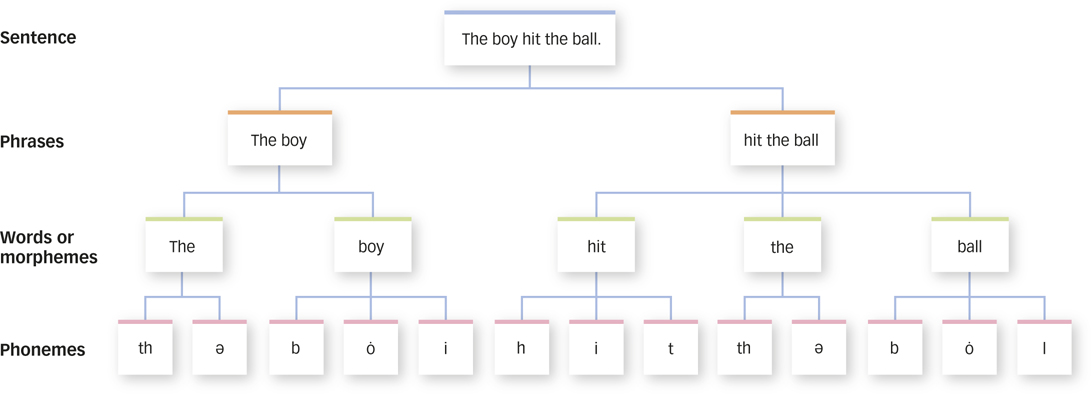
morphemes
The smallest meaningful units of language.
morphological rules
A set of rules that indicate how morphemes can be combined to form words.
Words can be combined and recombined to form an infinite number of new sentences, which are governed by syntactical rules, a set of rules that indicate how words can be combined to form phrases and sentences. A simple syntactical rule in English is that every sentence must contain one or more nouns and one or more verbs (see FIGURE 9.2). So, the utterance “dogs bark” is a full sentence, but “the big gray dog over by the building” is not.
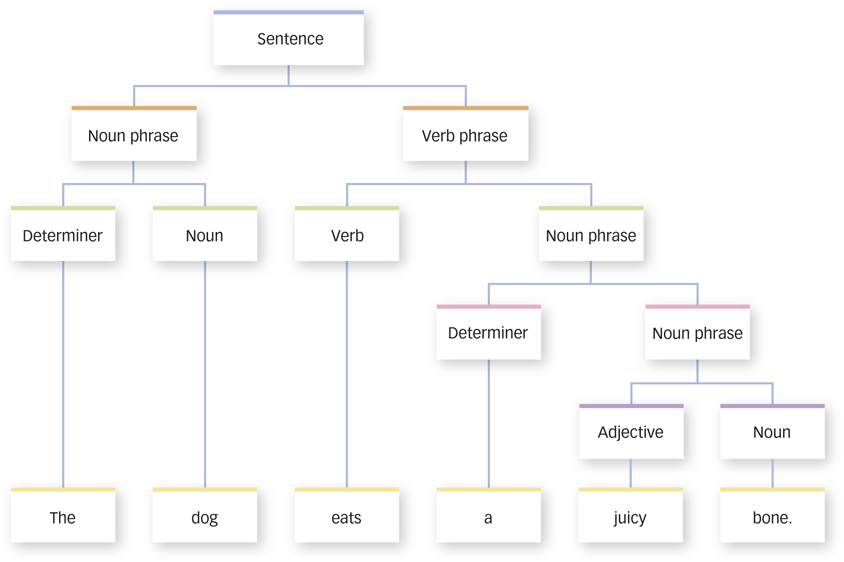
syntactical rules
A set of rules that indicate how words can be combined to form phrases and sentences.
Meaning: Deep Structure versus Surface Structure

Language usually conveys meaning quite well, but everyday experience shows us that misunderstandings can occur. These errors sometimes result from differences between the deep structure of sentences and their surface structure (Chomsky, 1957). Deep structure refers to the meaning of a sentence. Surface structure refers to how a sentence is worded. “The dog chased the cat” and “The cat was chased by the dog” mean the same thing (they have the same deep structure) even though on the surface, their structures are different.
deep structure
The meaning of a sentence.
surface structure
How a sentence is worded.
Is the meaning or wording of a sentence typically more memorable?
To generate a sentence, you begin with a deep structure (the meaning of the sentence) and create a surface structure (the particular words) to convey that meaning. When you comprehend a sentence, you do the reverse, processing the surface structure in order to extract the deep structure. After the deep structure is extracted, the surface structure is usually forgotten (Jarvella, 1970, 1971). In one study, researchers played tape-
276
Language Development
Language is a complex cognitive skill, yet we can carry on complex conversations with playmates and family before we begin school. Three characteristics of language development are worth bearing in mind. First, children learn language at an astonishingly rapid rate. The average 1-
Distinguishing Speech Sounds
What language ability do infants have that adults do not?
At birth, infants can distinguish all the sounds that occur in all human languages. Within the first 6 months of life, they lose this ability, and, like their parents, can only distinguish among the contrasting sounds in the language they hear being spoken around them. For example, two distinct sounds in English are the l sound and the r sound, as in lead and read. These sounds are not distinguished in Japanese; instead, the l and r sounds fall within the same phoneme. Japanese adults cannot hear the difference between these two phonemes, but American adults can distinguish between them easily—
277

In one study, researchers constructed a tape of a voice saying “la-
Infants can distinguish among speech sounds, but they cannot produce them reliably, relying mostly on cries, laughs, and other vocalizations to communicate. Between the ages of about 4 and 6 months, they begin to babble speech sounds. Babbling involves combinations of vowels and consonants that sound like real syllables but are meaningless. Regardless of the language they hear spoken, all infants go through the same babbling sequence. For example, d and t appear in infant babbling before m and n. Even deaf infants babble sounds they’ve never heard, and they do so in the same order as hearing infants do (Ollers & Eilers, 1988). This is evidence that infants aren’t simply imitating the sounds they hear and suggests that babbling is a natural part of the language development process. Recent research has shown that babbling serves as a signal that the infant is in a state of focused attention and ready to learn (Goldstein et al., 2010).
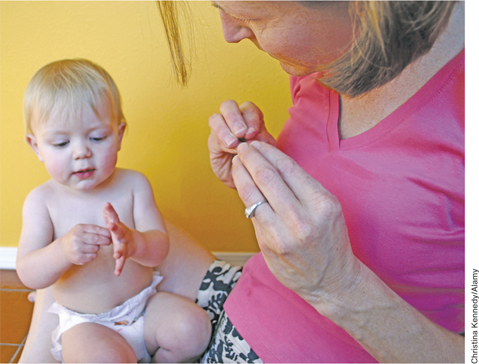
In order for vocal babbling to continue, however, infants must be able to hear themselves. In fact, delayed babbling or the cessation of babbling merits testing for possible hearing difficulties. Babbling problems can lead to speech impairments, but they do not necessarily prevent language acquisition. Deaf infants whose parents communicate using American Sign Language (ASL) begin to babble with their hands at the same age that hearing children begin to babble vocally—
Language Milestones
At about 10 to 12 months of age, infants begin to utter (or sign) their first words. By 18 months, they can say about 50 words and can understand several times more than that. Toddlers generally learn nouns before verbs, and the nouns they learn first are names for everyday, concrete objects (e.g., chair, table, milk) (see TABLE 9.1). At about this time, their vocabularies undergo explosive growth. By the time the average child begins school, a vocabulary of 5000 words is not unusual. By college, the average student’s vocabulary is about 10,000–
|
Average Age |
Language Milestones |
|---|---|
|
0- |
Can tell the difference between speech sounds (phonemes). Cooing, especially in response to speech. |
|
4– |
Babbles consonants. |
|
6– |
Understands some words and simple requests. |
|
10– |
Begins to use single words. |
|
12– |
Vocabulary of 30– |
|
18– |
Two- |
|
24– |
Vocabulary of about 1,000 words; production of phrases and incomplete sentences. |
|
36– |
Vocabulary grows to more than 10,000 words; production of full sentences, mastery of grammatical morphemes (such as –ed for past tense) and function words (such as the, and, but). Can form questions and negations. |
fast mapping
The fact that children can map a word onto an underlying concept after only a single exposure.
278
In what way do 2-
Around 24 months, children begin to form two-
telegraphic speech
Speech that is devoid of function morphemes and consists mostly of content words.
The Emergence of Grammatical Rules
If you listen to average 2-
Why is it unlikely that children are using imitation to pick up language?
These errors show that language acquisition is not simply a matter of imitating adult speech. Instead, children acquire grammatical rules by listening to the speech around them and using the rules to create verbal forms they’ve never heard. They manage this without explicit awareness of the grammatical rules they’ve learned. In fact, few children or adults can articulate the grammatical rules of their native language, yet the speech they produce obeys these rules.
279
By about 3 years of age, children begin to generate complete simple sentences that include function words (e.g., “Give me the ball” and “That belongs to me”). The sentences increase in complexity over the next 2 years. By 4 to 5 years of age, many aspects of the language acquisition process are complete. As children continue to mature, their language skills become more refined, with added appreciation of subtler communicative uses of language, such as humor, sarcasm, or irony.
Language Development and Cognitive Development
Language development typically unfolds as a sequence of steps in which one milestone is achieved before moving on to the next. Nearly all infants begin with one-
Why are studies of internationally adopted children especially useful?
To tease apart these possibilities, researchers examined the acquisition of English by internationally adopted children who did not know any English prior to adoption (Snedeker, Geren, & Shafto, 2007, 2012). If the orderly sequence of milestones that characterizes the acquisition of English by infants is a by-
Theories of Language Development
We know a good deal about how language develops, but what underlies the process? The language acquisition process has been the subject of considerable controversy and (at times) angry exchanges among scientists coming from three different approaches: behaviorist, nativist, and interactionist.
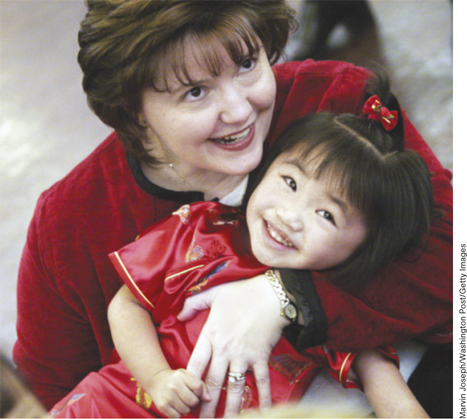
Behaviorist Explanations
According to B. F. Skinner’s behaviorist explanation of language learning, we learn to talk in the same way we learn any other skill: through reinforcement, shaping, extinction, and the other basic principles of operant conditioning that you learned about in the Learning chapter (Skinner, 1957). As infants mature, they begin to vocalize. Those vocalizations that are not reinforced gradually diminish, and those that are reinforced remain in the developing child’s repertoire. So, for example, when an infant gurgles “prah,” most parents are pretty indifferent. However, “da-
280
The behavioral explanation is attractive because it offers a simple account of language development, but it cannot account for many fundamental characteristics of language development (Chomsky, 1986; Pinker, 1994; Pinker & Bloom, 1990).
- First, parents don’t spend much time teaching their children to speak grammatically. So, for example, when a child says, “Nobody like me,” his or her mother will respond with something like, “Why do you think that?” rather than “Now, listen carefully and repeat after me: Nobody likes me” (Brown & Hanlon, 1970).
- Second, children generate sentences that they’ve never heard before. This shows that children don’t just imitate; they learn the rules for generating sentences.
- Third, as you read earlier, the errors children make when learning to speak tend to be overgeneralizations of grammatical rules. The behaviorist explanation would not predict these overgeneralizations if children were learning through trial and error or simply imitating what they hear.
To a behaviorist, why will an infant repeat “da-
Nativist Explanations
In a blistering reply to Skinner’s behaviorist approach, linguist Noam Chomsky (1957, 1959) argued that language-
nativist theory
The view that language development is best explained as an innate, biological capacity.

The story of Christopher, whom you met earlier in the chapter, is consistent with the nativist view of language development: His genius for language acquisition, despite his low overall intelligence, indicates that language capacity can be distinct from other mental capacities. Other individuals show the opposite pattern: People with normal or nearly normal intelligence can find certain aspects of human language difficult or impossible to learn. This condition is known as genetic dysphasia, a syndrome characterized by an inability to learn the grammatical structure of language despite having otherwise normal intelligence. For example, when asked to describe what she did over the weekend, one child wrote, “On Saturday I watch TV.” Her teacher corrected the sentence to “On Saturday, I watched TV,” drawing attention to the -ed rule for describing past events. The following week, the child was asked to write another account of what she did over the weekend. She wrote, “On Saturday I wash myself and I watched TV and I went to bed.” Notice that although she had memorized the past-
genetic dysphasia
A syndrome characterized by an inability to learn the grammatical structure of language despite having otherwise normal intelligence.
What is the evidence that language and intelligence are separate abilities?
281
Also consistent with the nativist view is evidence that language can be acquired only during a restricted period of development. This was dramatically illustrated by the tragic case of Genie (Curtiss, 1977). At the age of 20 months, Genie was tied to a chair by her parents and kept in virtual isolation. Her father forbade Genie’s mother and brother to speak to her, and he himself only growled and barked at her. She remained in this brutal state until she was rescued at the age of 13. Genie’s life improved substantially, and she received years of language instruction, but it was too late. Her language skills remained extremely primitive. She developed a basic vocabulary and could communicate her ideas, but she could not grasp the grammatical rules of English.
Less dramatic evidence for a restricted period in human learning comes from studies of language acquisition in immigrants. In one study, the proficiency with which immigrants spoke English depended not on how long they’d lived in the United States, but on their age at immigration, with those who had arrived as children being more proficient than those who arrived after puberty (Johnson & Newport, 1989). More recent work using fMRI shows that acquiring a second language early in childhood (between 1 and 5 years of age) results in very different representation of that language in the brain than does acquiring that language much later (after 9 years of age; Bloch et al., 2009).
Interactionist Explanations
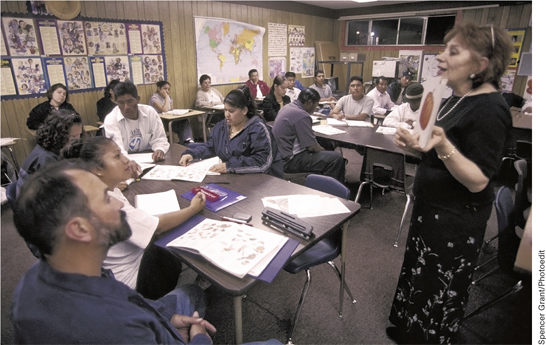
Nativist theories are often criticized because they do not explain how language develops; they merely explain why. The interactionist approach holds that although infants are born with an innate ability to acquire language, social interactions also play a crucial role in language. Interactionists point out that parents tailor their verbal interactions with children in ways that simplify the language acquisition process: They speak slowly, enunciate clearly, and use simpler sentences than they do when speaking with adults (Bruner, 1983; Farrar, 1990).
How does the interactionist theory of language acquisition differ from behaviorist and nativist theories?
Further evidence of the interaction of biology and experience comes from a fascinating study of deaf children’s creation of a new language (Senghas, Kita, & Ozyurek, 2004). Prior to about 1980, deaf children in Nicaragua stayed at home and usually had little contact with other deaf individuals. In 1981, some deaf children began to attend a new school. At first, the school did not teach a formal sign language, and none of the children had learned to sign at home, but the children gradually began to communicate using hand signals that they invented. Initially, the gestures were simple, but over the past three decades, the Nicaraguan sign language has developed considerably, and it now contains many of the same features as more mature languages, including signs to describe separate components of complex concepts (Pyers et al., 2010). These acts of creation nicely illustrate the interplay of nativism (the predisposition to use language) and experience (growing up in an insulated deaf culture).
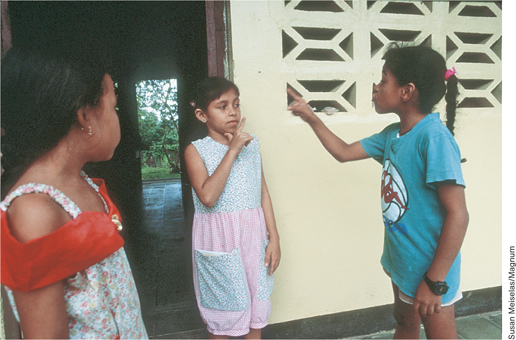
Language Development and the Brain

In early infancy, language processing is distributed across many areas of the brain. But as the brain matures, language processing gradually becomes more and more concentrated in two areas, Broca’s area and Wernicke’s area. Broca’s area is located in the left frontal cortex and is involved in the production of the sequential patterns in vocal and sign languages (see FIGURE 9.3). Wernicke’s area, located in the left temporal cortex, is involved in language comprehension (whether spoken or signed).
282
Together, Broca’s area and Wernicke’s area are sometimes referred to as the language centers of the brain; damage to them results in a serious condition called aphasia, difficulty in producing or comprehending language. As you saw in the Psychology: Evolution of a Science chapter, patients with damage to Broca’s area understand language relatively well, although they have increasing comprehension difficulty as grammatical structures get more complex. But their real struggle is with speech production. Typically, they speak in short, staccato phrases that consist mostly of content morphemes: “Ah, Monday, uh, Casey park. Two, uh, friends, and, uh, 30 minutes.” On the other hand, patients with damage to Wernicke’s area can produce grammatical speech, but it tends to be meaningless: “Feel very well. In other words, I used to be able to work cigarettes. I don’t know how. Things I couldn’t hear from are here.”
aphasia
Difficulty in producing or comprehending language.
As important as Broca’s and Wernicke’s areas are for language, they are not the entire story. A number of neuroimaging studies have revealed evidence of right-

Brain changes also appear to account for the fact that children who are fluent in two languages score higher than monolingual children on several measures of cognitive functioning, including executive control capacities such as the ability to prioritize information and flexibly focus attention (Bialystok, 1999, 2009; Bialystok, Craik, & Luk, 2012). The idea here is that bilingual individuals benefit from exerting executive control in their daily lives when they attempt to suppress the language that they don’t want to use. Research shows that learning a second language produces lasting changes in the brain (Mechelli et al., 2004; Stein et al., 2009). For example, the gray matter in a part of the left parietal lobe that is involved in language is denser in bilingual than in monolingual individuals, and the increased density is most pronounced in those who are most proficient in using their second language (Mechelli et al., 2004). (Some other benefits of bilingualism are noted in the Other Voices box.)
How does fluency in two languages change the brain?
283
Other Voices: Americans’ Future Has to Be Bilingual
Americans’ Future Has to Be Bilingual
We discuss in the text some benefits of bilingualism that have been documented in recent research. Linda Moore (2012) noted several such benefits in the following article from The Washington Diplomat and argued that the American educational system should teach students foreign languages earlier than is commonly done.

We Americans must confront a stark disadvantage we face when it comes to the global economy. Some eight in 10 Americans speak only English, and the number of schools teaching a foreign language is in decline, according to a new study by the Council on Foreign Relations. But the opposite is true among our economic competitors.
While some 200 million Chinese students are learning English, only 24,000 Americans are studying Chinese, U.S. Department of Education statistics say. Foreign language degrees account for only 1 percent of all U.S. undergraduate degrees. And fewer than 2 percent of U.S. undergraduates study abroad in a given year, the Education Department says.
Our nation is largely monolingual but is entering an increasingly multilingual world. More than half of European Union citizens speak a language other than their mother tongue, and more than a quarter speak at least three languages. This is because additional languages are studied in European primary and secondary schools, and are taken up by European college students in much larger numbers than in the United States.
The Council on Foreign Relations-
For decades, our children were deprived of bilingual or multilingual education out of a mistaken belief that it took time away from other subjects, hindering students’ academic development. But recent research has shown that learning another language is a wise investment, rather than a waste. Research from the University of Georgia found that bilingual school children perform better on standardized tests, including the Scholastic Aptitude Test (SAT) than their monolingual peers. A George Mason University study discovered that younger students who had enrolled in a second language immersion program outperformed those who did not in coursework, as well as on standardized tests, throughout their scholastic careers.
Educators now conclude that learning additional languages improves one’s ability to focus, plan and solve problems. Among other benefits, this means that such students are better able to move efficiently from one subject to another. The D.C.-based Center for Applied Linguistics has ascertained that the earlier we learn a foreign language, the greater the benefits. Moreover, these benefits can last a lifetime. Learning another language can help people stave off the effects of aging, including preventing the onset of dementia and other age-
I believe that teaching students foreign languages in pre-
Exposure to a new language and the skills it helps develop is a key reason that our school, where 80 percent of our students come from low-
The benefits of learning a new language go beyond the classroom. When students graduate, being fluent in a second language improves their career prospects. The Bureau of Labor Statistics reports that a number of emerging occupations need workers who can speak and write in more than one language. A University of Florida study revealed that in large, linguistically diverse cities such as Miami and San Antonio, the ability to speak a second language translates into more than $7,000 of increased annual income. We want our students to have access to these opportunities and more.
The economic importance of being bilingual is highlighted by the fact that 31 percent of company executives can speak at least two languages, according to international executive search firm Korn/Ferry.
Using multilingualism, we are expanding the scope of children’s learning at a time when public policy limits school accountability to math and reading. Most policymakers want their children to have global skill sets but do not encourage this in our public schools.
Other countries have learned this lesson and have made the necessary commitments to teach their students additional languages. Their students’ exposure to additional languages is paying dividends. I would like to see the U.S. Department of Education encourage local education authorities to invest in bilingual and multilingual education. Given the global competition for good jobs, this is not a luxury, but a necessity. It will help our children, and our nation, to succeed in the economy of tomorrow.
Are you convinced by Moore’s argument? If not, why not? And if so, how far do you think the educational system should go in promoting multilingual education? What about the possible impact of devoting more time in early grades to teaching languages on other subjects? What kinds of research would you want to see done to evaluate the effects of early instruction in foreign languages?
Moore, L. (August 31, 2012). America’s Future Has to Be Bilingual. In The Washington Diplomat. Copyright 2012 TheWashington Diplomat. Reproduced by permission. http:/
SUMMARY QUIZ [9.1]
Question 9.1
| 1. | The combining of words to form phrases and sentences is governed by |
- phonological rules.
- morphological rules.
- structural rules.
- syntactical rules.
d.
Question 9.2
| 2. | Which of the following statements about language development is inaccurate? |
- Language acquisition is largely a matter of children imitating adult speech.
- Deep structure refers to the meaning of a sentence, while surface structure refers to how it is constructed.
- By the time the average child begins school, a vocabulary of 10,000 words is not unusual.
- Children’s passive mastery of language develops faster than their active mastery.
a.
284
Question 9.3
| 3. | Language development as an innate, biological capacity is explained by |
- fast mapping.
- behaviorism.
- nativist theory.
- interactionist explanations.
c.
Question 9.4
| 4. | Damage to the brain region called Broca’s area results in |
- failure to comprehend language.
- difficulty in producing grammatical speech.
- the reintroduction of infant babbling.
- difficulties in writing.
b.